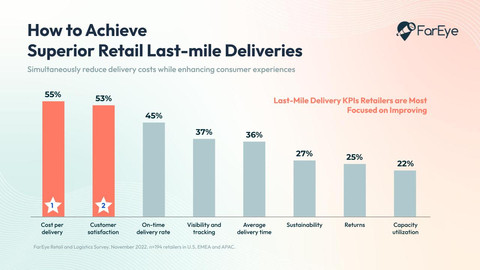
FarEye’s Eye on Last-mile Delivery Report Finds 84% of Retailers Lack Control of their Outsourced Delivery Networks
FarEye Previews Research Results from Retailers; Last-mile Priorities Focused on Reducing Cost to Deliver While Improving Consumer Experience
-

FarEye’s Eye on Last-mile Delivery Report Finds 84% of Retailers Lack Control of their Outsourced Delivery Networks
CHICAGO--(Business Wire / Korea Newswire)--The FarEye Eye on Last-mile Delivery Report, conducted with Researchscape International, explores retailers’ and logistics providers’ last-mile delivery priorities and opportunities over the next five years.
Since 2020, last-mile delivery has gone through a transformation, yielding a complex, expensive, inefficient, and unsustainable process. To reduce growing last-mile delivery costs, FarEye’s research revealed that 57% of retailers have outsourced their delivery networks over the past five years, yet 84% of retailers claim their organization needs more control over their outsourced delivery networks.
In a climate where revenue growth, efficiency and sustainability are key priorities for every company, last-mile delivery strategies must adapt to balance reducing delivery costs and improving consumer experiences.
Retailers Favor Outsourced Delivery Networks Which Lack Control
Outsourced delivery networks yield lower cost, faster delivery, and increased capacity but sacrifice control over order tracking and a branded consumer experience. The trend for retailers to outsource their delivery networks contrasts with the fact that only 27% of retailers are using one last-mile delivery platform yet 72% believe it is extremely or very beneficial to merge all technology solutions into one platform, offering a single view, more agility, control and lower cost.
“For retailers that do not have the scale for their own fleet of drivers, outsourcing their delivery networks is the most cost-effective way to deliver with flexibility, however, the tradeoff is less control,” said Stephane Gagne, vice president, product, FarEye. “Rather than outsource their entire last-mile logistics network, retailers should consider having their own last-mile platform that would provide them the flexibility to experiment with different hybrid multi-carrier approaches, outsourcing in some markets, and insourcing in others. This would offer the level of control and visibility they are after, while retaining a superior consumer experience.”
Retailers’ Top Priorities are Balancing Cost of Delivery and Consumer Satisfaction
Last-mile delivery is expensive, accounting for 53% of overall shipping costs. Fifty-five percent of retailers surveyed are focused on reducing cost of delivery over the next five years, in addition to increasing customer satisfaction (53%) as their top two priorities.
The top factors contributing to the high cost of last-mile delivery include: fuel (59%), address location (39%), labor (36%) and first delivery failure (34%). The speed to deliver is a contributing factor as only 44% of retailers reported that all or almost all of their deliveries are made on-time today, however, retailers have a goal of increasing that rate to nearly 70% in 2027. In addition, 35% of retailers reported offering same- or next-day delivery now, and 64% aim to offer it by 2027.
“Instead of speed, retailers should consider improving the reliability of orders through AI and machine learning technology that will help them route orders accurately and efficiently, and ensure carrier allocation and capacity levels match demand,” noted Gagne.
Last-mile Delivery Growth Priorities
In terms of last-mile delivery outlook, 66% of retailers expect their budgets for last-mile delivery technology to grow over the next five years, and 78% of retailers claim they will likely change or buy a new last-mile delivery solution in the next 1-2 years. Forty-eight percent of retailers expect to buy a last-mile delivery platform in the next five years, vs. building their own in-house (32%).
By 2027, retailers also plan to expand their carrier fleets to be more sustainable. Sixty percent of EMEA and APAC respondents and 40% of U.S. respondents planned to use electric vehicles in their fleets in the next five years. Autonomous vehicles are a priority for 43% of APAC respondents, 25% for U.S. and 20% for EMEA respondents, and drones were a priority for 34% of APAC respondents, 29% of EMEA respondents and 22% of U.S. respondents, over the next five years.
Research Methodology
The FarEye Eye on Last-mile Delivery research will be released in two parts, in January and February 2023. FarEye analyzed responses from 300 leaders across retail and logistics with responsibility for logistics and retail operations in the U.S. (32%), EMEA (36%) and APAC (32%) regions.
About FarEye
FarEye’s Delivery Management platform turns deliveries into a competitive advantage. Retail, e-commerce and third-party logistics companies use FarEye’s unique combination of orchestration, real-time visibility, and branded customer experiences to simplify complex last-mile delivery logistics. The FarEye platform allows businesses to increase consumer loyalty and satisfaction, reduce costs and improve operational efficiencies. FarEye has 150+ customers across 30 countries and five offices globally. FarEye, First Choice for Last Mile.
View source version on businesswire.com: https://www.businesswire.com/news/home/20230126005266/en/
Website: https://fareye.com/
View Korean version of this release
Contact
FarEye
Jolene Peixoto
VP, marketing strategy & communications
This is a news release distributed by Korea Newswire on behalf of this company.

